wlanHEMUConfig
Configure HE MU transmission
Description
The wlanHEMUConfig object is a configuration object for the WLAN
high-efficiency multi-user (HE MU) packet format.
Creation
Description
cfgHEMU = wlanHEMUConfig(AllocationIndex,Name,Value)wlanHEMUConfig([200 114 114
200],'LowerCenter26ToneRU',true) specifies an 80 MHz bandwidth allocation for
three users on three RUs with lower center 26-tone RU allocation signaling.
At runtime, the calling function validates object settings for properties relevant to the operation of the function.
Properties
Resource unit (RU) allocation index for each 20 MHz subchannel. This property defines the number of RUs, the size of each RU, and the number of users assigned to each RU. For more information, see Allocation Index.
You can specify this value as an integer, a vector of integers, a string array, a character vector, or a cell array of character vectors. The format in which you specify these indices depends on how many you are specifying.
Specify a single allocation index using one integer in either of these forms.
An integer in the interval [0, 223]
An 8-bit binary sequence specified as a string or character vector
Specify multiple allocation indices using two, four, or eight integer values in any of these forms.
A vector of integers in the interval [0, 223]
An 8-bit binary sequence specified as a string array
An 8-bit binary sequence specified as a cell array of character vectors
In an 80 MHz transmission, you can signal a punctured 20 MHz subchannel at any location.
In a 160 MHz transmission, you can signal a punctured 20 or 40 MHz subchannel. You can only signal a punctured 20 MHz subchannel in the 40 MHz subchannel containing the primary 20 MHz subchannel, as shown in this figure.

Similarly, you can only signal a punctured 40 MHz subchannel in the 80 MHz subchannel containing the primary 20 MHz subchannel, as shown in this figure.

To signal a punctured 20 MHz subchannel, set the corresponding element of this property to
113. To signal a punctured 40 MHz subchannel, set the two corresponding adjacent elements to114.To signal an empty HE-SIG-B user field in an HE-SIG-B content channel, set the corresponding element of this property to
114or115.
Note
This property is read-only after the object is created.
Data Types: double | char | string | cell
Channel bandwidth of PPDU transmission, specified as one of these values:
'CBW20'– Channel bandwidth of 20 MHz'CBW40'– Channel bandwidth of 40 MHz'CBW80'– Channel bandwidth of 80 MHz'CBW160'– Channel bandwidth of 160 MHz
When you create a wlanHEMUConfig object, this property is
configured based on the value to which you set the AllocationIndex property.
Note
This property is read-only after the object is created.
Data Types: char | string
Enable lower center 26-tone RU allocation signaling, specified as a numeric or
logical 1 (true) or 0
(false). To enable the lower frequency center 26-tone RU, set this
property to 1 (true). This property can be set
during object creation only.
Dependencies
This property applies only when the AllocationIndex property defines a channel bandwidth of 80 MHz or 160
MHz and does not specify a full bandwidth allocation.
Data Types: logical
Enable upper center 26-tone RU allocation signaling, specified as a numeric or
logical 1 (true) or 0
(false). To enable the upper frequency center 26-tone RU, set this
property to 1 (true). This property can be set
during object creation only.
Dependencies
This property applies only when the AllocationIndex property defines a channel bandwidth of 80 MHz or 160
MHz and does not specify a full bandwidth allocation.
Data Types: logical
Transmission properties of each RU in the transmission, specified as a cell array of
wlanHEMURU objects. When you
create a wlanHEMUConfig object, the AllocationIndex property determines this property.
Data Types: cell
Transmission properties of each user, specified as a cell array of wlanHEMUUser objects. When you
create a wlanHEMUConfig object, the AllocationIndex property determines this property.
Data Types: cell
Index of primary 20 MHz subchannel in an 80 or 160 MHz transmission, specified as one of these options.
When the
ChannelBandwidthproperty is'CBW80', set this property to an integer in the interval [1, 4].When the
ChannelBandwidthproperty is'CBW160', set this property to an integer in the interval [1, 8].
The location of the primary subchannel and the preamble puncturing pattern (defined
by the AllocationIndex property) determine the bandwidth value signaled in the
HE-SIG-A field of the transmission, as specified in Table 27-20 of [2].
Dependencies
This property applies only when the AllocationIndex property defines a channel bandwidth of 80 MHz or 160
MHz.
Data Types: double
Number of transmit antennas, specified as a positive integer.
Data Types: double
Cyclic shift values, in nanoseconds, of additional transmit antennas for the pre-HE
fields of the waveform. The first eight antennas use the cyclic shift values specified
in Table 21-10 of [1].
The remaining L antennas use the values you specify in this property,
where L = NumTransmitAntennas –
8. Specify this property as one of these values:
An integer in the interval [–200, 0] – the
wlanHEMUConfigobject uses this cyclic shift value for each of the L additional antennas.A row vector of length L of integers in the interval [–200, 0] – the
wlanHEMUConfigobject uses the kth element as the cyclic shift value for the (k + 8)th transmit antenna.Note
If you specify this property as a row vector of length greater than L, the
wlanHEMUConfigobject uses only the first L elements. For example, if you set theNumTransmitAntennasproperty to16, thewlanHEMUConfigobject uses only the first L = 16 – 8 = 8 elements of this vector.
Dependencies
To enable this property, set the NumTransmitAntennas property to a value greater than
8.
Data Types: double
Enable space-time block coding (STBC) of the PPDU data field for all users,
specified as a numeric or logical 1 (true) or
0 (false). STBC transmits multiple copies of the
data stream across assigned antennas.
When you set this property to
0(false), STBC is not applied to the data field. The number of space-time streams is equal to the number of spatial streams.When you set this property to
1(true), STBC is applied to the data field. The number of space-time streams is twice the number of spatial streams.
Dependencies
This property applies only when all of these conditions are satisfied:
The
NumSpaceTimeStreamssubproperty of each element of theUserproperty is2.The
MCSsubproperty of each element of theUserproperty is0(false).No RU specifies multi-user multiple input/multiple output (MU-MIMO).
Data Types: logical
Guard interval (cyclic prefix) duration for the data field within a packet, in
microseconds, specified as 3.2, 1.6, or
0.8.
Data Types: double
HE-LTF compression mode, specified as 4 or 2.
This property indicates the type of HE-LTF, where a value of 4 or
2corresponds to four times or two times HE-LTF duration compression
mode, respectively. The HE-LTF type is enumerated in Table 27-1 of [2]
as:
2xHE-LTF – Duration of 6.4 μs with a guard interval duration of 0.8 μs or 1.6 μs
4xHE-LTF – Duration of 12.8 μs with a guard interval duration of 0.8 μs or 3.2 μs
For more information on the HE-LTF, see section 27.3.11.10 of [2].
Data Types: double
HE-SIG-B compression indicator, specified as a numeric or logical
1 (true) or 0
(false). To enable HE-SIG-B compression for a full-bandwidth 20 MHz
MU-MIMO transmission, set this property to 1
(true).
Dependencies
This property applies only when you indicate a 20 MHz channel bandwidth by setting
the AllocationIndex to a value in the interval [192,199].
Note
This property is not used for bandwidths of 40, 80, or 160 MHz because, at these
bandwidths, the AllocationIndex alone determines if HE-SIG-B
compression is used:
If you specify a single, full-band allocation index, the transmission uses HE-SIG-B compression. The allocation index is not signaled.
If you specify 2, 4, or 8 full-band allocation indices, the transmission does not use HE-SIG-B compression. The allocation indices are signaled.
For more information, see the tutorial on HE MU Transmission or the example Demonstrate SIGB Compression in HE MU Waveforms.
Data Types: logical
Modulation and coding scheme (MCS) for the HE-SIG-B field, specified as an integer in the interval [0, 5].
Data Types: double
HE-SIG-B dual-carrier modulation (DCM) indicator, specified as a numeric or logical
1 (true) or 0
(false). A value of 1 (true)
indicates that the HE-SIG-B field is modulated with DCM. A value of 0
(false) indicates that the HE-SIG-B field is not modulated with
DCM.
Dependencies
This property applies only when the MCS
subproperty of each element of the User
property is 0, 1, 3, or
4.
Data Types: logical
Uplink indication, specified as a numeric or logical 1
(true) or 0 (false). To
indicate that the PPDU is sent on a downlink transmission, set this property to
0 (false). To indicate that the PPDU is sent on
an uplink transmission, set this property to 1
(true).
Data Types: logical
Basic service set (BSS) color identifier, specified as an integer in the interval [0, 63].
Data Types: double
Spatial reuse indication, specified as an integer in the interval [0, 15].
Data Types: double
Duration information for transmit opportunity (TXOP) protection, specified as an
integer in the interval [0, 127]. Except for the first bit, which specifies TXOP length
granularity, each bit of the TXOP field of HE-SIG-A is equal to
TXOPDuration. Therefore a duration in microseconds must be
converted according to the procedure set out in Table 27-18 of [2].
Data Types: double
High-Doppler mode indicator, specified as a numeric or logical 0
(false) or 1 (true). To
indicate high-Doppler mode in the HE-SIG-A field, set this property to
1 (true).
Dependencies
The 1 (true) value for this property is
valid only when the NumSpaceTimeStreams subproperty of each element of the RU property
is less than or equal to 4.
Data Types: logical
Midamble periodicity of the HE-data field, in number of OFDM symbols, specified as
10 or 20.
Dependencies
This property applies only when the HighDoppler
property is 1 (true).
Data Types: double
Object Functions
getNumPostFECPaddingBits | Calculate required number of post-FEC padding bits |
getPSDULength | Calculate HE or WUR PSDU length |
packetFormat | WLAN packet format |
ruInfo | Resource unit allocation information |
showAllocation | Resource unit allocation |
transmitTime | Packet transmission time |
Examples
Create a 20 MHz multiuser HE configuration object with the allocation index set to 0. An allocation index of 0 specifies nine 26-tone RUs in a 20 MHz channel.
cfgMU = wlanHEMUConfig(0); for i=1:numel(cfgMU.User) % Set the APEPLength of each user cfgMU.User{i}.APEPLength = 100; end
Display the configuration object properties for the fourth user.
cfgMU.User{4}ans =
wlanHEMUUser with properties:
APEPLength: 100
MCS: 0
NumSpaceTimeStreams: 1
DCM: 0
ChannelCoding: 'LDPC'
STAID: 0
NominalPacketPadding: 0
PostFECPaddingSource: 'mt19937ar with seed'
PostFECPaddingSeed: 4
Read-only properties:
RUNumber: 4
Create an HE MU configuration object for a 40 MHz transmission with an allocation index of 11000000 for each 20 MHz subchannel. This configuration specifies two 242-tone RUs, each with one user.
cfgHEMU = wlanHEMUConfig(["11000000" "11000000"],'NumTransmitAntennas',2);
Configure the first RU and the first user.
cfgHEMU.RU{1}.SpatialMapping = 'Direct';
cfgHEMU.User{1}.APEPLength = 1e3;
cfgHEMU.User{1}.MCS = 2;
cfgHEMU.User{1}.NumSpaceTimeStreams = 2;
cfgHEMU.User{1}.ChannelCoding = 'LDPC';
cfgHEMU.User{1}.NominalPacketPadding = 16;Configure the second RU and the second user.
cfgHEMU.RU{2}.SpatialMapping = 'Fourier';
cfgHEMU.User{2}.APEPLength = 500;
cfgHEMU.User{2}.MCS = 3;
cfgHEMU.User{2}.NumSpaceTimeStreams = 1;
cfgHEMU.User{2}.ChannelCoding = 'LDPC';
cfgHEMU.User{2}.NominalPacketPadding = 8;Display the configuration object properties for both RUs and both users.
disp(cfgHEMU)
wlanHEMUConfig with properties:
RU: {[1×1 wlanHEMURU] [1×1 wlanHEMURU]}
User: {[1×1 wlanHEMUUser] [1×1 wlanHEMUUser]}
NumTransmitAntennas: 2
STBC: 0
GuardInterval: 3.2000
HELTFType: 4
SIGBMCS: 0
SIGBDCM: 0
UplinkIndication: 0
BSSColor: 0
SpatialReuse: 0
TXOPDuration: 127
HighDoppler: 0
Read-only properties:
ChannelBandwidth: 'CBW40'
AllocationIndex: [192 192]
cfgHEMU.RU{1:2}ans =
wlanHEMURU with properties:
PowerBoostFactor: 1
SpatialMapping: 'Direct'
Read-only properties:
Size: 242
Index: 1
UserNumbers: 1
ans =
wlanHEMURU with properties:
PowerBoostFactor: 1
SpatialMapping: 'Fourier'
Read-only properties:
Size: 242
Index: 2
UserNumbers: 2
cfgHEMU.User{1:2}ans =
wlanHEMUUser with properties:
APEPLength: 1000
MCS: 2
NumSpaceTimeStreams: 2
DCM: 0
ChannelCoding: 'LDPC'
STAID: 0
NominalPacketPadding: 16
PostFECPaddingSource: 'mt19937ar with seed'
PostFECPaddingSeed: 1
Read-only properties:
RUNumber: 1
ans =
wlanHEMUUser with properties:
APEPLength: 500
MCS: 3
NumSpaceTimeStreams: 1
DCM: 0
ChannelCoding: 'LDPC'
STAID: 0
NominalPacketPadding: 8
PostFECPaddingSource: 'mt19937ar with seed'
PostFECPaddingSeed: 2
Read-only properties:
RUNumber: 2
HE MU-MIMO Configuration With SIGB Compression
Generate a full bandwidth HE MU-MIMO configuration at 20 MHz bandwidth with SIGB compression. All three users are on a single content channel, which includes only the user field bits.
cfgHE = wlanHEMUConfig(194); cfgHE.NumTransmitAntennas = 3;
Create PSDU data for all users.
psdu = cell(1,numel(cfgHE.User)); psduLength = getPSDULength(cfgHE); for j = 1:numel(cfgHE.User) psdu = randi([0 1],psduLength(j)*8,1,'int8'); end
Generate and plot the waveform.
y = wlanWaveformGenerator(psdu,cfgHE); plot(abs(y))
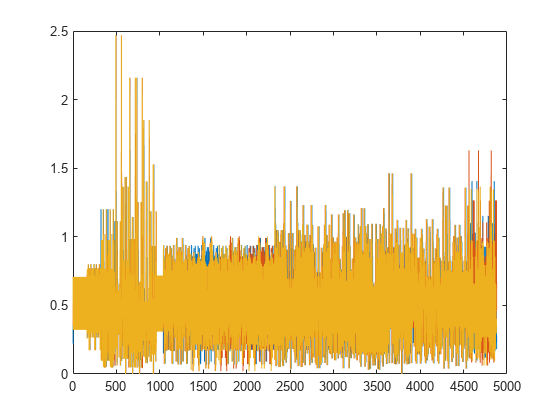
Generate a full bandwidth HE MU-MIMO waveform at 80 MHz bandwidth with SIGB compression. HE-SIG-B content channel 1 has four users. HE-SIG-B content channel 2 has three users.
cfgHE = wlanHEMUConfig(214); cfgHE.NumTransmitAntennas = 7;
Create PSDU data for all users.
psdu = cell(1,numel(cfgHE.User)); psduLength = getPSDULength(cfgHE); for j = 1:numel(cfgHE.User) psdu = randi([0 1],psduLength(j)*8,1,'int8'); end
Generate and plot the waveform.
y = wlanWaveformGenerator(psdu,cfgHE); plot(abs(y));

HE MU-MIMO Configuration Without SIGB Compression
Generate a full bandwidth HE MU-MIMO configuration at 20 MHz bandwidth without SIGB compression. All three users are on a single content channel, which includes both common and user field bits.
cfgHE = wlanHEMUConfig(194); cfgHE.SIGBCompression = false; cfgHE.NumTransmitAntennas = 3;
Create PSDU data for all users.
psdu = cell(1,numel(cfgHE.User)); psduLength = getPSDULength(cfgHE); for j = 1:numel(cfgHE.User) psdu = randi([0 1],psduLength(j)*8,1,'int8'); end
Generate and plot the waveform.
y = wlanWaveformGenerator(psdu,cfgHE); plot(abs(y))
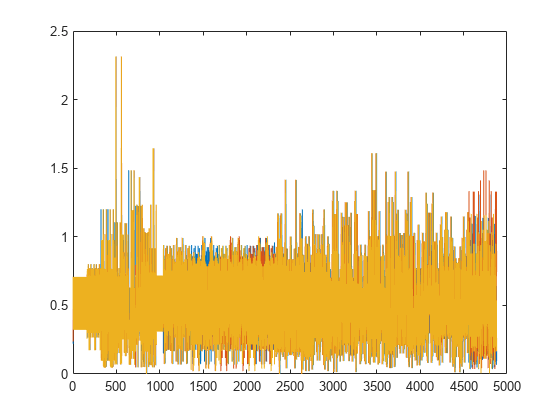
Generate an 80 MHz HE MU waveform for six users without SIGB compression. HE-SIG-B content channel 1 has four users. HE-SIG-B content channel 2 has two users.
cfgHE = wlanHEMUConfig([202 114 192 193]); cfgHE.NumTransmitAntennas = 6; for i = 1:numel(cfgHE.RU) cfgHE.RU{i}.SpatialMapping = 'Fourier'; end
Create PSDU data for all users.
psdu = cell(1,numel(cfgHE.User)); psduLength = getPSDULength(cfgHE); for j = 1:numel(cfgHE.User) psdu = randi([0 1],psduLength(j)*8,1,'int8'); end
Generate and plot the waveform.
y = wlanWaveformGenerator(psdu,cfgHE); plot(abs(y));
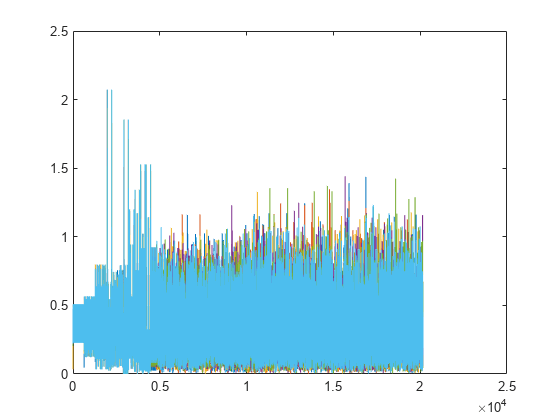
Generate a full bandwidth HE MU-MIMO waveform at 80 MHz bandwidth without SIGB compression. HE-SIG-B content channel 1 has seven users. HE-SIG-B content channel 2 has zero users.
cfgHE = wlanHEMUConfig([214 115 115 115]); cfgHE.NumTransmitAntennas = 7;
Create PSDU data for all users.
psdu = cell(1,numel(cfgHE.User)); psduLength = getPSDULength(cfgHE); for j = 1:numel(cfgHE.User) psdu = randi([0 1],psduLength(j)*8,1,'int8'); end
Generate and plot the waveform.
y = wlanWaveformGenerator(psdu,cfgHE); plot(abs(y))
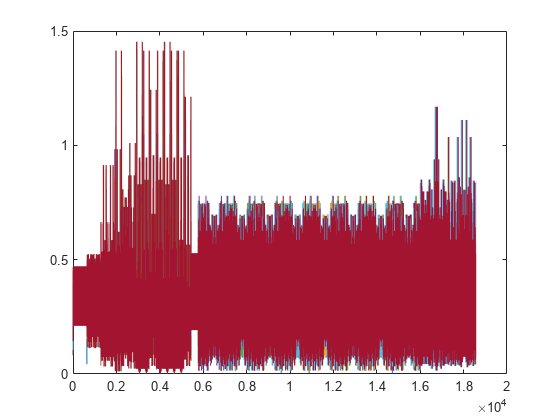
Create an 80 MHz MU-MIMO configuration with three users in a single RU with SIG-B compression. Display the configuration object properties.
cfgMU = wlanHEMUConfig(210);
cfgMU.NumTransmitAntennas = 3;
cfgMU.User{1}.NumSpaceTimeStreams = 1;
cfgMU.User{2}.NumSpaceTimeStreams = 1;
cfgMU.User{3}.NumSpaceTimeStreams = 1;
disp(cfgMU) wlanHEMUConfig with properties:
RU: {[1×1 wlanHEMURU]}
User: {[1×1 wlanHEMUUser] [1×1 wlanHEMUUser] [1×1 wlanHEMUUser]}
NumTransmitAntennas: 3
STBC: 0
GuardInterval: 3.2000
HELTFType: 4
SIGBMCS: 0
SIGBDCM: 0
UplinkIndication: 0
BSSColor: 0
SpatialReuse: 0
TXOPDuration: 127
HighDoppler: 0
Read-only properties:
ChannelBandwidth: 'CBW80'
AllocationIndex: 210
Create a 160 MHz configuration using the upper center 26-tone RU. A total of four RUs are created. The RU tone assignments are 996, 484, 484, and 26. One user is allocated to each RU. The last RU created is the center 26-tone RU. Display the configuration properties of the object.
cfgMU = wlanHEMUConfig([208 115 115 115 200 114 114 200], ... 'UpperCenter26ToneRU',true); cfgMU.RU{:}
ans =
wlanHEMURU with properties:
PowerBoostFactor: 1
SpatialMapping: 'Direct'
Read-only properties:
Size: 996
Index: 1
UserNumbers: 1
ans =
wlanHEMURU with properties:
PowerBoostFactor: 1
SpatialMapping: 'Direct'
Read-only properties:
Size: 484
Index: 3
UserNumbers: 2
ans =
wlanHEMURU with properties:
PowerBoostFactor: 1
SpatialMapping: 'Direct'
Read-only properties:
Size: 484
Index: 4
UserNumbers: 3
ans =
wlanHEMURU with properties:
PowerBoostFactor: 1
SpatialMapping: 'Direct'
Read-only properties:
Size: 26
Index: 56
UserNumbers: 4
This example shows how to disable a user in an HE MU transmission.
Create an HE MU configuration object with allocation index equal to 112. This specifies four 52-tone RUs in a 20 MHz channel bandwidth. Each RU has one user.
cfg = wlanHEMUConfig(112);
Display the allocation.
showAllocation(cfg)

Set the STAID property of the third user to 2046. This specifies that the RU that corresponds to the third user transmits no data.
cfg.User{3}.STAID = 2046;Display the allocation.
showAllocation(cfg)
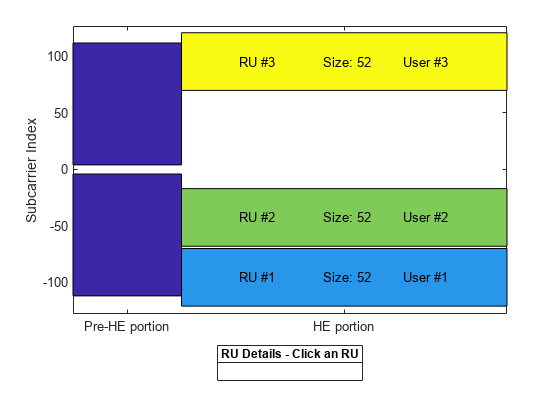
More About
The physical layer (PHY) protocol data unit (PPDU) is the complete physical layer convergence procedure (PLCP) frame, including PLCP headers, MAC headers, the MAC data field, and the MAC and PLCP trailers.
When you create a wlanHEMUConfig object, the properties
are set based on the chosen AllocationIndex
property and any name-value pairs you include. Upon creation of the object, RU and User cell arrays
are configured. The RU cell array elements contain the configuration
properties for each RU. The User cell array elements contain the
configuration properties for each user.
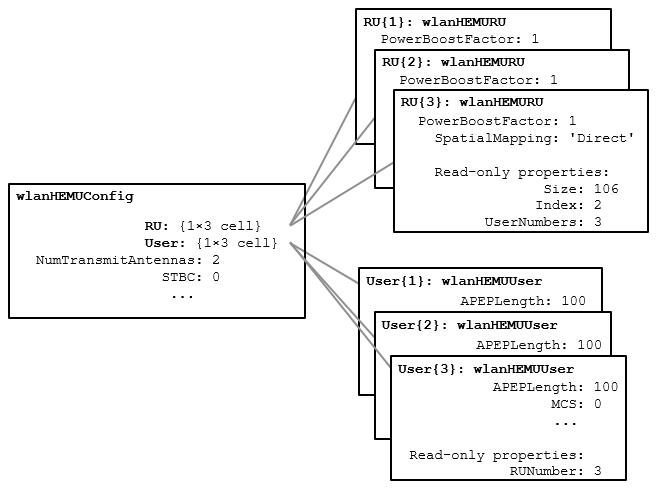
The UserNumbers subproperty of the RU property
indicates which users are transmitted on each RU.
The RUNumber subproperty of the User property
indicates which RUs are used to transmit data for each user.
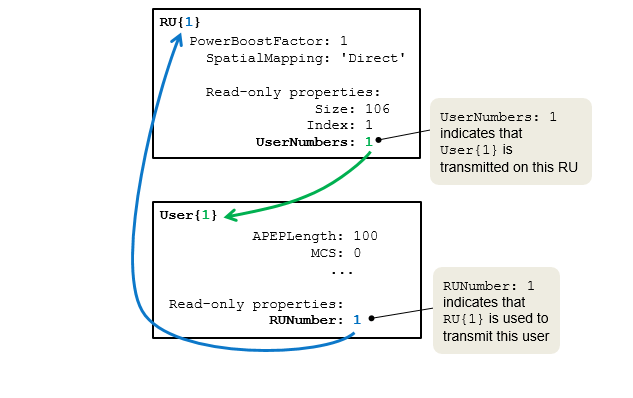
As shown here, an RU can be assigned to multiple users.
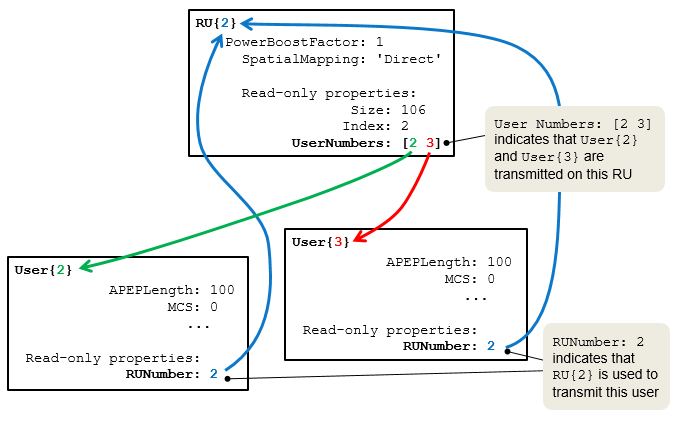
After creating the object, you can modify some of the RU and
User properties, but other RU and
User properties are read-only. For more information about the
elements of the RU cell array, see wlanHEMURU. For more information about
the elements of the User cell array, see wlanHEMUUser.
References
[1] IEEE Std 802.11-2020 (Revision of IEEE Std 802.11-2016). “Part 11: Wireless LAN Medium Access Control (MAC) and Physical Layer (PHY) Specifications.” IEEE Standard for Information Technology — Telecommunications and Information Exchange between Systems — Local and Metropolitan Area Networks — Specific Requirements.
[2] IEEE Std 802.11ax™-2021 (Amendment to IEEE Std 802.11-2020). “Part 11: Wireless LAN Medium Access Control (MAC) and Physical Layer (PHY) Specifications. Amendment 1: Enhancements for High Efficiency WLAN.” IEEE Standard for Information Technology — Telecommunications and Information Exchange between Systems. Local and Metropolitan Area Networks — Specific Requirements.
Extended Capabilities
You must specify the data type of the postFECPaddingBits
subproperty of the user property as int8.
Version History
Introduced in R2018b
MATLAB Command
You clicked a link that corresponds to this MATLAB command:
Run the command by entering it in the MATLAB Command Window. Web browsers do not support MATLAB commands.
选择网站
选择网站以获取翻译的可用内容,以及查看当地活动和优惠。根据您的位置,我们建议您选择:。
您也可以从以下列表中选择网站:
如何获得最佳网站性能
选择中国网站(中文或英文)以获得最佳网站性能。其他 MathWorks 国家/地区网站并未针对您所在位置的访问进行优化。
美洲
- América Latina (Español)
- Canada (English)
- United States (English)
欧洲
- Belgium (English)
- Denmark (English)
- Deutschland (Deutsch)
- España (Español)
- Finland (English)
- France (Français)
- Ireland (English)
- Italia (Italiano)
- Luxembourg (English)
- Netherlands (English)
- Norway (English)
- Österreich (Deutsch)
- Portugal (English)
- Sweden (English)
- Switzerland
- United Kingdom (English)